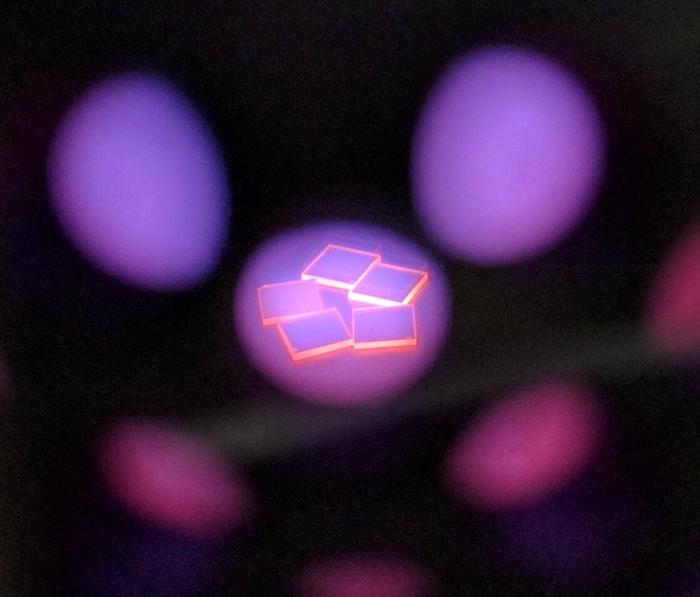Diamonds show promise for spintronic devices

Diamond plates undergoing surface termination treatment in a hydrogen plasma. Credit: Daniel Creedon Usage Restrictions: This image may be used only with appropriate credit.
Conventional electronics rely on controlling electric charge. Recently, researchers have been exploring the potential for a new technology, called spintronics, that relies on detecting and controlling a particle's spin. This technology could lead to new types of more efficient and powerful devices.
In a paper published in Applied Physics Letters, from AIP Publishing, researchers measured how strongly a charge carrier's spin interacts with a magnetic field in diamond. This crucial property shows diamond as a promising material for spintronic devices.
Diamond is attractive because it would be easier to process and fabricate into spintronic devices than typical semiconductor materials, said Golrokh Akhgar, a physicist at La Trobe University in Australia. Conventional quantum devices are based on multiple thin layers of semiconductors, which require an elaborate fabrication process in an ultrahigh vacuum.
“Diamond is normally an extremely good insulator,” Akhgar said. But, when exposed to hydrogen plasma, the diamond incorporates hydrogen atoms into its surface. When a hydrogenated diamond is introduced to moist air, it becomes electrically conductive because a thin layer of water forms on its surface, pulling electrons from the diamond. The missing electrons at the diamond surface behave like positively charged particles, called holes, making the surface conductive.
Researchers found that these holes have many of the right properties for spintronics. The most important property is a relativistic effect called spin-orbit coupling, where the spin of a charge carrier interacts with its orbital motion. A strong coupling enables researchers to control the particle's spin with an electric field.
In previous work, the researchers measured how strongly a hole's spin-orbit coupling could be engineered with an electric field. They also showed that an external electric field could tune the strength of the coupling.
In recent experiments, the researchers measured how strongly a hole's spin interacts with a magnetic field. For this measurement, the researchers applied constant magnetic fields of different strengths parallel to the diamond surface at temperatures below 4 Kelvin. They also simultaneously applied a steadily varying perpendicular field. By monitoring how the electrical resistance of the diamond changed, they determined the g-factor. This quantity could help researchers control spin in future devices using a magnetic field.
“The coupling strength of carrier spins to electric and magnetic fields lies at the heart of spintronics,” Akhgar said. “We now have the two crucial parameters for the manipulation of spins in the conductive surface layer of diamond by either electric or magnetic fields.”
Additionally, diamond is transparent, so it can be incorporated into optical devices that operate with visible or ultraviolet light. Nitrogen-vacancy diamonds — which contain nitrogen atoms paired with missing carbon atoms in its crystal structure — show promise as a quantum bit, or qubit, the basis for quantum information technology. Being able to manipulate spin and use it as a qubit could lead to yet more devices with untapped potential, Akhgar said.
###
The article, “G-factor and well width variations for the two-dimensional hole gas in surface conducting diamond,” is authored by Golrokh Akhgar, Daniel L. Creedon, Alastair Stacey, David Hoxley, Jeffrey C. McCallum, Lothar Ley, Alex R. Hamilton and Chris Pakes. The article appeared in Applied Physics Letters Jan. 23, 2018 (DOI: 10.1063/1.5010800) and can be accessed at http://aip.
ABOUT THE JOURNAL
Applied Physics Letters features concise, rapid reports on significant new findings in applied physics. The journal covers new experimental and theoretical research on applications of physics phenomena related to all branches of science, engineering, and modern technology. See http://apl.
Media Contact
All latest news from the category: Physics and Astronomy
This area deals with the fundamental laws and building blocks of nature and how they interact, the properties and the behavior of matter, and research into space and time and their structures.
innovations-report provides in-depth reports and articles on subjects such as astrophysics, laser technologies, nuclear, quantum, particle and solid-state physics, nanotechnologies, planetary research and findings (Mars, Venus) and developments related to the Hubble Telescope.
Newest articles

NASA: Mystery of life’s handedness deepens
The mystery of why life uses molecules with specific orientations has deepened with a NASA-funded discovery that RNA — a key molecule thought to have potentially held the instructions for…

What are the effects of historic lithium mining on water quality?
Study reveals low levels of common contaminants but high levels of other elements in waters associated with an abandoned lithium mine. Lithium ore and mining waste from a historic lithium…

Quantum-inspired design boosts efficiency of heat-to-electricity conversion
Rice engineers take unconventional route to improving thermophotovoltaic systems. Researchers at Rice University have found a new way to improve a key element of thermophotovoltaic (TPV) systems, which convert heat…



